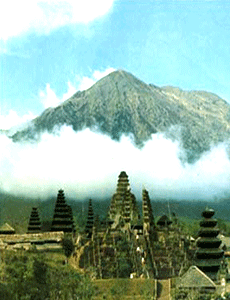BALI ANJANI VACATIONS provides accommodations, hotels, villas, Tour Packages and General Information for your lovely holiday in Bali and Beyond
A tragic incident occurred while he and his people were on the island named Pulau Dawa; Pulau means island and Dawa means long. They worked hard to prepare the land for cultivation. Unfortunately, some wild animals and a strange epidemic killed many of his people. The tragedy caused great despair to the Maha Yogi, who returned to Mount Rawung and only revisited Pulau Dawa some years later.
When Rsi Markandiya returned to Pulau Dawa, he brought with him a group of people from the village of Aga in Mount Rawung. Before they started the hard land work, several rituals were held, and Rsi Markandiya performed a special ritual called Panca Datu. This ritual incorporated 5 elements… namely gold, silver, and bronze, a metal material (like tin or iron) and a red diamond. Rsi Markandiya named the site of the ritual as Basuki, which means 'Bless'. Nowadays, the area is popularly known as Besakih.
The people of Aga are now known as the Bali Aga; Bali from the word Wali means holy sacrifice and Aga means mountain. Rsi Markandiya organized his people and taught them farming, and introduced a structured social system. Thus, the island civilization of Bali started at a sacred place in the foot of Mount Agung, where a temple complex still stands majestically to this day.
Besakih temple is an extensive complex with 23 temples. The largest temple inside the complex is Pura Penataran Agung which is dedicated to Shiva. Other temples include Pura Kiduling Kreteg, representing Brahma, the Creator; and Pura Batu Madeg, representing Wisnu, the Preserver.
These three manifestations of God are known as Tri Murti. Besides these temples, there are also temples representing Panca Dewata; 5 Godly manifestations that protect the centre of the complex and the 4 directions radiating north, south, east & west of the centre. On the right and left side of Pura Penataran Agung, there are clusters of temples called pedarman where people come to pray and give offerings to their ancestors.
The complex is vast and hilly, so it is advisable to get a guide who is capable and has a good knowledge of the temple complex; otherwise you'll have to do the best you can on your own with a brochure and guide map. Indeed, there many things one can observe and appreciate in the temple complex. For example, one can appreciate the magnificent carvings which tell some epic stories of the Ramayana and Mahabrata dynasties. These decorative carvings form a part of the temple's traditional architecture, along with and Kamasan style paintings which are very ancient. Please note that tourists are not allowed inside the temples.
The best time to visit Besakih is in the morning or late evening. The breeze, the quiet environment, and the superb view down to the coast – particularly when there is no mist, add so much to the ambience of the complex. Besides, during these times of the day, not so many people are in the temple complex, and the crowds of people who call themselves temple guardians – and usually convince tourists to go around under their guidance – are not yet roaming around the complex, so one may have a hassle-free tour.
The temple which is located in Klungkung Regency is a unique heritage for all Balinese people; and indeed, Besakih has its own unique charm. It is believed that the temple area is surrounded with mystical supernatural powers. In 1963, when Mount Agung erupted, Besakih was the only place to survive from the lava explosion, even though it is nestled on the foot of the mountain. It is every Balinese's dream to pay homage to the Gods of Besakih, and the temple has a very important role in the history of Balinese civilization.
More Info :
- Find Temple Besakih location on Google Map
- Temple Besakih Gallery Photo
- Program to visit Temple Besakih : Full Day Besakih Tour
- Program to visit Temple Besakih : Tour Around Bali
- Place of interest to visit Bali







No comments:
Post a Comment